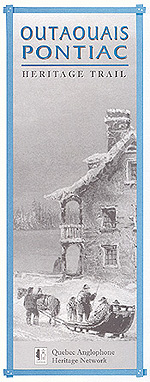
The Outaouais-Pontiac Heritage Trail leads to pioneer settlements and historic sites on the Quebec side of the Ottawa River, from Aylmer to Fort Coulonge.
This famous river linked First Nations villages for centuries and became Canada’s main fur-trade route to the upper Great Lakes. Algonquin traders used the waterway to bring pelts from Huron territory to French merchants at Quebec and Montreal. The French named it Rivière des Outaouais for the Ottawa tribe who were the colony’s most important fur suppliers.
British and American immigrants started staking claim to the region in the early 1800s. Philemon Wright, from Massachusetts, sent the first timber raft down the Ottawa River in 1800. He founded a settlement at the foot of Chaudière Falls that became the city of Hull.
The valley’s old-growth pine and oak trees disappeared as loggers and settlers moved further upstream. Much of the Anglophone heritage you’ll glimpse on this tour is rooted in the wood trade and the westward flow of settlers in the 19th century.
This tour mainly follows Rte. 148, but many side-trips are possible. Be sure to bring along a Quebec roadmap and a copy of the Official Tourist Guide to the Outaouais, which lists accomodations and services in the region.
Other Resources
Aylmer, Quebec: Its Heritage, son patrimoine. Book by Diane Aldred. Published by the Aylmer Heritage Association. ISBN 0-929114-02-7.
Treasures of the Pontiac in Song and Story. Book published by Dickson Enterprises, Shawville. ISBN 0-919942-04-0.
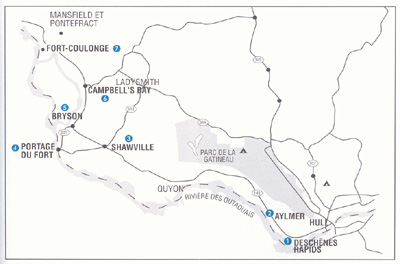 Getting There
Getting There
From the City of Gatineau (Hull) take Rte. 148 west and head for Aylmer. From Ottawa, take the Champlain Bridge and follow the signs for Aylmer Road. Drive west till Vanier Road. Turn left and continue straight until you meet the river. We’ll begin our exploration with a short walk; there’s free parking here beside a paved walking path.
DESCHÊNES RAPIDS
A few minutes downstream along the path you’ll come to the remains of a dam. Robert Conroy, an Irish settler, harnessed these rapids in the mid-1800s to run his flour and saw mills. In 1895, Conroy’s sons Robert and William built the region’s first hydro-electric plant here. It powered the Hull Electric Railway, which began service between Ottawa and Aylmer in 1896.
Drive back up Vanier Road toward Aylmer Road. As you cross Lucerne Blvd., note the long greystone building to your right: rail cars were stored here during the heyday of the electric train.
AYLMER (Population: 36,000)
In 1805 a six-mile trail was blazed between Hull and a boat landing on Lake Deschênes. Aylmer Road and its extension, rue Principale, follows the original pioneer road.
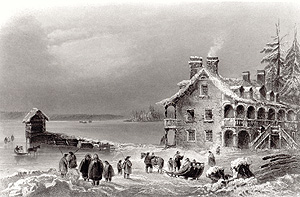 Pioneers first knew this settlement as Chaudière Farm. Later it was called Symmes Village. As steamboat service on the river grew in the 1830s, Aylmer’s harbour became a busy forwarding point. The rapids between Hull and Aylmer made boat navigation impossible, so passengers and cargo journeyed overland by horse and carriage to their steamboat connection.
Pioneers first knew this settlement as Chaudière Farm. Later it was called Symmes Village. As steamboat service on the river grew in the 1830s, Aylmer’s harbour became a busy forwarding point. The rapids between Hull and Aylmer made boat navigation impossible, so passengers and cargo journeyed overland by horse and carriage to their steamboat connection.
Many pre-Confederation buildings may be glimpsed along rue Principale, including a stone mansion built in 1840 by Aylmer’s first mayor, Irishman John Egan. In 1937 the Egan house was incorporated into a large stone monastery on rue Principale, just west of Wilfird Lavigne Blvd.
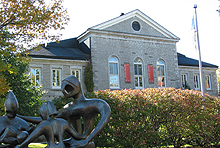 The old courthouse and jail facing the park at Principale and Broad streets was built in 1852. Today it houses Aylmer’s cultural centre. Further along is the prominent British Hotel, built in 1841 for Robert Conroy to accommodate riverboat passengers.
The old courthouse and jail facing the park at Principale and Broad streets was built in 1852. Today it houses Aylmer’s cultural centre. Further along is the prominent British Hotel, built in 1841 for Robert Conroy to accommodate riverboat passengers.
The beautifully restored Symmes Inn overlooking the marina on Lake Deschênes was built in 1831 by Charles Symmes, a nephew of Philemon Wright. In 2003 the building opened its doors as the Symmes Inn Museum.
Aylmer Heritage Association: (819) 684-6809
Museum: (819) 682-0291
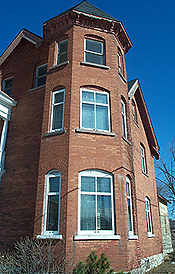 SHAWVILLE (Population: 1,700)
SHAWVILLE (Population: 1,700)
The first settlers in the Shawville area were Irish Protestants from County Tipperary who immigrated to Canada after the Napoleonic Wars. Pioneers Thomas Hodgins, John Dale and his wife Elizabeth are credited with choosing this spot in the 1820s to start their farms.
Shawville has seven churches. The village cemetery on rue Principale is among the oldest in the region.
Pontiac’s agricultural heritage is celebrated each year over Labour Day weekend during the Shawville Exhibition. The annual Steam Show features steam-powered tractor and threshing demonstrations. Historical information panels have been erected at various sites. The local historical society operates a small museum in the old railway station. To arrange a tour of historical Shawville and the museum, contact Shawville Revitalization at (819) 647-5233.
Shawville Fair Information: (819) 647-3213
Pontiac Historical Society Archives: (819) 647-5620
Optional side-trip: The German hamlet of Ladysmith, north of Shawville on Rte. 303 is home to St. John's Lutheran Church, built in 1898. Greermount, a hamlet between Campbell’s Bay and Ladysmith boasts a lovely stone church, St. Stephen’s Anglican, built in 1886.
PORTAGE DU FORT
Like many settlements on the Ottawa River, this village below the Chenaux Rapids got its start as a canoe landing. In the early 1800s, the village developed to meet the needs of travelers, lumbermen and settlers.
At one time, three quarries operated nearby. Visitors will find several heritage stone buildings, including the Roman Catholic and Anglican churches built in 1850 and 1856 respectively. Portage du Fort native Elsie Gibbons, a cook on a boat that towed logs on the river, became Quebec’s first woman mayor in 1953.
BRYSON
Bryson was a stopover during the steamboat era. In the 1880s, before the metal bridge was built, passengers were taken to Grand Calumet Island by ferry.
Named for John Bryson, MP for Pontiac between 1882 and 1896, the village served as the county seat until 1914. St. James’ Anglican cemetery is a monument to the town’s many English-speaking pioneers.
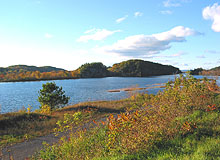 CAMPBELL’S BAY
CAMPBELL’S BAY
Home to the Pontiac district’s Regional Municipal Council (MRC), this town commands a wonderful view of the Ottawa River. It was settled by lumberers and farmers in the mid 1800s. Travelers may wish to visit the old Protestant graveyard on the north side of Rte. 148, at the entrance to the village.
The brick courthouse and jail was built here in 1926-27. The interior, noted for its intricate woodwork, may be visited weekdays. Call (819) 648-5222.
FORT COULONGE-DAVIDSON
The French established a fur-trading post here near the mouth of the Coulonge River in the 17th century. It was sold to the North West Company in the 1760s and bought by the Hudson’s Bay Company in 1821. A wooden cross in Davidson marks the site of the trading-post graveyard. In the 1830s, Scottish immigrant George Bryson acquired timber rights in the area from which he built his fortune.
St-Andrew’s Presbyterian Church in Fort Coulonge was built by the Bryson family and is the only church in the Pontiac with a copper roof.
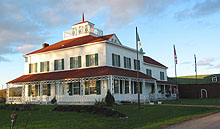 West of the village on Rte. 148 is the prominent clapboard Bryson House, built for the lumber baron and his wife Robina Cobb in 1854. Declared an historical monument in 1980, the mansion is distinguished by extensive outbuildings and a roof-top tower. It’s now home to the municipal library.
West of the village on Rte. 148 is the prominent clapboard Bryson House, built for the lumber baron and his wife Robina Cobb in 1854. Declared an historical monument in 1980, the mansion is distinguished by extensive outbuildings and a roof-top tower. It’s now home to the municipal library.
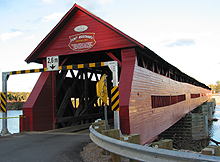 Across the highway is the Marchand Bridge, the longest covered bridge in Quebec, built in 1898. Be sure to visit Spruceholme, a large mansion that once belonged to George Bryson Jr. Built in 1875, the house has been restored and is now an elegant inn and restaurant.
Across the highway is the Marchand Bridge, the longest covered bridge in Quebec, built in 1898. Be sure to visit Spruceholme, a large mansion that once belonged to George Bryson Jr. Built in 1875, the house has been restored and is now an elegant inn and restaurant.
To learn more about Quebec’s logging heritage, follow the blue tourist signs on Rte. 148 leading to Coulonge Falls Park. The park is open from May 1 to Oct. 31.
Coulonge Park: (819) 683-2770
Bryson House: (819) 683-2944
Spruceholme: (819) 683-2139
The Heritage Trail series is presented by the Quebec Anglophone Heritage Network, funded jointly by the Department of Canadian Heritage and Economic Development Canada. Space constraints preclude mention of all possible sites. Thanks to Enid Page of the Aylmer Heritage Association and Bonnie Richardson of Shawville Revitalization. For more information call the QAHN office at (819) 564-9595 or toll free within Quebec at 1 (877) 964-0409.![]()
![]()